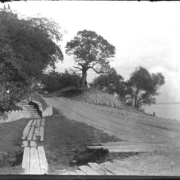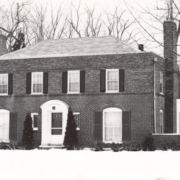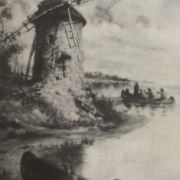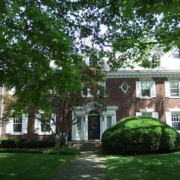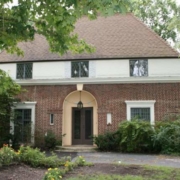Historical Architecture of Grosse Pointe – there is no finer place to call home – a history of Grosse Pointe
In celebration of Independence Day yesterday, we wanted to take this opportunity to take you back in time and share with you a brief history of our prominent and much loved community.
We will start with a very brief history of Detroit and then explore Grosse Pointe a little further.
During the period of 1701 through to 1796 three flags were flown over Detroit, first came the French, then the British followed by the Americans in 1796.
Having been occupied primarily by the French, Detroit surrendered to the English in 1760. Under this new flag many of the French settlers left the city and moved to Grosse Pointe to join the large French contingent that had made the area their home, having arrived in the region around 1701.

French map of Detroit, c. 1701 Courtesy of the Burton Historical Collection, Detroit Public LIbrary
The majority of the French occupied much of the farmland that was so important to this area. During this era it is believed the area was heavily wooded and swampy, however it proved to be a great area for farming. Many of the early farms generally had around 300 feet of water frontage, ran a mile inland and were owned by some very now familiar names – Rivard, Venier, Renaud and Kerby.
It is believed the name Grosse Pointe was in place before Detroit became an American territory in 1796. Based on research from the Grosse Pointe Historical Society ‘the name Grosse Pointe undoubtedly referred to the broad, flat point, which culminated at the Windmill Pointe lighthouse. The French word “grosse” has a meaning that lies between grande and grasse, and seems well applied to this blunt point. Furthermore, all of the point lying east of Jefferson, the “river road,” was the Grand Marais (Great Swamp), and the names Grosse Pointe and Grand Marais were used interchangeably for many years’. Source: Grosse Pointe History Timeline, Grosse Pointe Historical Society.
Lakeshore, originally an early Indian trail, later became a well-traveled route along the lake. In 1851 the road became known as Jefferson Avenue.

From 1850 to 1900 lumbermen cleared the woods and wealthy Detroit businessmen used the land to build large summer cottages for their families on the shores of Lake St. Clair. It was fast becoming a summer colony; the new residents gave their new residences names such as Maplehurst, Tonnancour, Summerside, Cloverleigh and the Poplars.

Summer Cottage – Courtesy of – digitalcollections.detroitpubliclibrary.org

Summer Cottage – Courtesy of – digitalcollections.detroitpubliclibrary.org

Summer Cottage – Courtesy of – digitalcollections.detroitpubliclibrary.org

Summer Cottage – Courtesy of – digitalcollections.detroitpubliclibrary.org
The new summer homes were typical of the Gothic Revival and Queen Anne architectural styles of that period. Given this was where families would be spending their summers the majority of the properties were set in picturesque settings with well manicured lawns and elegant flower gardens. Few of the original properties remain, however some stunning examples of ‘turn of the century’ summer cottages can still be found on Lake Shore, including several homes constructed before 1900, including: 365, 301, 71, 207 and 755 Lake Shore.

365 Lake Shore – Courtesy of Grosse Pointe Historical Society
It wasn’t just the homes that were changing; the territories were being transformed too.
In 1879 Grosse Pointe Village was organized and included only the property between Fisher Road and Weir Lane. In 1889, Grosse Pointe Village was extended south to Cadieux Road. The area was rich in produce and exported fruit, fish and grain.

“The Point,’ Grosse Pointe, 1886” – Courtesy of – digitalcollections.detroitpubliclibrary.org
According to research from the Historical Society, in 1893 ‘an argument arose as to the sale of liquor in a roadhouse called “Termont’s,” which stood on part of the Frederick M. Alger property. It resulted in the organization of a new village, Grosse Pointe Farms, which took the old boundaries of Fisher Road and Weir Lane’.
In 1915, the section of Jefferson Avenue located in Grosse Pointe was officially named Lakeshore Rd.

Lake Shore – Courtesy of – digitalcollections.detroitpubliclibrary.org
Due to the paving of Lakeshore for the growing ownership of automobiles, and the desire for many Detroit’s wealthy residents to move out of the city, Grosse Pointe Farms quickly transitioned from a summer colony to a year-round residential community. The summer cottages were demolished clearing the way for large mansions and their formal landscaped gardens – most visibly on Lake Shore. These homes included Rose Terrace, the Standish Backus estate and the Roy Chapin mansion.

Rose Terrace – Courtesy of Grosse Pointe Historical Society

Backus Mansion – Courtesy of Grosse Pointe Historical Society

Roy Chapin Mansion – Courtesy of – digitalcollections.detroitpubliclibrary.org
Throughout the 1920 & 30’s a golden era of architectural was underway throughout Grosse Pointe. Nationally noteworthy Architects – that were based in Detroit – came to the community during this period and designed a significant amount of the new homes. These architects defined an architectural style that is still visible today, and many historically significant buildings surround us.
Today Grosse Pointe continues to grow, prosper and transform. In 2009 the Village of Grosse Pointe Shores was reincorporated as a city.
The area continues to receive national and statewide recognition for its historically noteworthy buildings. As of 2016 Grosse Pointe has a thriving historical society, around 15 recognized Michigan Historic markers and 10 buildings are listed on the National Register of Historic Places, including the latest addition the Grosse Pointe Yacht Club – added in 2015.

Grosse Pointe Yacht Club – Courtesy of Grosse Pointe Historical Society
With a passionate and extremely proud community Grosse Pointe continuously recognizes its roots, and takes its place in history as a significant and independent area – there is no finer place to call home.
*Photos courtesy of the Higbie Maxon Agney archives unless stated.
Written by Katie Doelle
Copyright © 2016 Katie Doelle

